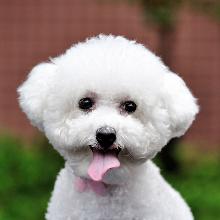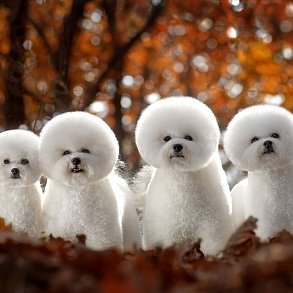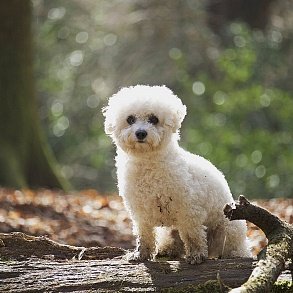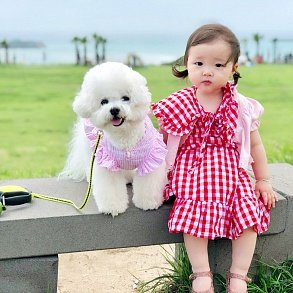Bichon frise

Bichon frise (French lapdog) is a miniature plush "antidepressant" and a charming minx with whom you will not be bored.
Brief information
- Breed name: Bichon frise
- Country of origin: France, Belgium
- Weight: 2.5-3 kg
- Height (height at the withers): 25-30 cm
- Lifespan: 12-15 years
Highlights
- French lapdogs do not have a specific dog smell and do not shed, therefore they belong to the category of hypoallergenic breeds.
- In training, they show themselves as capable, but somewhat undisciplined students who require a special approach.
- Dogs of this breed are excellent companions, recommended for families with children.
- Despite their diminutive size and generally unprotected appearance, bichons do not need excessive care. Owners who sin like this risk getting a cowardly, capricious and spoiled animal, unable to build an adequate dialogue with other dogs.
- Due to their sociable nature, French lapdogs are not suitable for busy and often absent from home people.
- Frieze bichons are great mischievous and restless pranksters.
Bichon frise - decorative dogs with curly snow-white fur, which are closely related to the lapdogs. The soft airy "fur coat" gives the bichons a strong resemblance to a powder puff, which gives the animals a unique charm. The fashion for this breed was introduced in the era of the gloomy Middle Ages by the French kings. As a result, for a long period of time affectionate and extremely active bichons remained constant companions of monarchs, emphasizing the high social status of their owners.
Breed characteristics
History of the Bichon Frise breed
The past of French lapdogs, if not covered with mystery and darkness, is thoroughly confused. According to experts, the distant ancestors of the Frieze bichons were small white dogs, which in turn were descendants of water barbets. Curly-haired fuzzies inhabited the coast and islands of the Mediterranean Sea and were very successful in catching rats, for which they were often settled on ships. The first name of the breed sounded like "bar-bichon". "Bar", abbreviated from "barbet", and "bichon" in French means "velvet cushion".
Over time, the genus of white dogs with curls has grown substantially, as a result of which such branches as Bolognese (Italian lapdog), maltese (Maltese lapdog) have "budded" from it and the Tenerife bichon. The latter variety was especially popular among the European elite during the Renaissance and, in fact, gave rise to the modern breed of French lapdogs.
By the XIII century, bichons acquired the status of an element of luxury. A French lapdog puppy could be presented as an exclusive gift, or used as a live currency at the conclusion of the transaction. The special popularization of the breed was promoted by Francis I. The Knight-king kept an incalculable number of lapdogs at his court, to which a new nickname was glued at that time: "infanta dogs".
After the French Revolution, interest in bichons gradually faded away. From the palace rooms, the dogs quickly moved to the streets of Paris, from where they migrated to traveling circus troupes. The official name "Bichon Frise" was given to the breed by the International Cynological Association in 1933. A year later, general standards for the appearance of French lapdogs were formulated. As for the spread of the breed, the favorites of Francis I reached the USA only in the 50s of the last century, and in England bichons began to be bred only in the mid-70s .
Video: Bichon frise
Appearance of frieze bichons
It's hard to find a more touching creature than French lapdogs. Drowning in their airy "fur coats", they resemble weightless white clouds, while the miniature dimensions of the animals give them a resemblance to a soft wind-up toy. Like the vast majority of representatives of the room-decorative breed, Frieze bichons have an inexhaustible reserve of charm. The size of an adult usually does not exceed 30 cm, and the weight is 3-5 kg.
Head
Proportional, with a flat skull shape (the fluffy fur of the animal gives a rounded look to the head) and the same flat cheekbones. The nose is round, with black skin. Muzzle with a wide base, gradually tapering towards the nose. The transition from the frontal part to the muzzle is not clearly expressed.
Lips
Thin, black color. With the mouth closed, the lower lip is usually not visible.
Jaws
A scissor bite is considered an ideal parameter, but some felinological associations also allow a straight bite. The jaws are wide, with even incisors.
Eyes
Round black (sometimes brown), arranged in a straight line, the whites are not visible. The skin around the eyes is pigmented in black, emphasizing the contrast between the light coat and the organs of vision.
Ears
The ears of the bichon frise are hanging, repeating the shape of an isosceles triangle. The exemplary length in the elongated state is up to the corners of the lips. Covered with long, wavy hair.
Neck
Long (1/3 of the length of the entire body), set high, thin at the base of the skull and with a smooth thickening as it approaches the withers.
Body
Compact in size, with a strong, straight back and a wide, slightly curved loin. The chest is of moderate width, deeply lowered, with a pronounced sternum.
Limbs
The distinctive features of the forelimbs are a thin backbone. The legs are straight, the elbows look back. The shoulders are oblique, not protruding. The hind limbs are smooth, with a muscular and wide femoral part. The shape of the paws is rounded, with elastic black pads and fingers gathered in a "ball".
Tail
The tail of the bichon frise is abundantly covered with lush hair, located well below the back and equal to half the length of the body. It is not docked. The animal experiencing positive emotions lifts its tail up and holds it parallel to the spine. In this case, the outer hair (suspension) may come into contact with the back, but the tail itself does not.
Wool
Curly, airy, not prone to knocking down into so-called "cords", 7 to 10 cm long. The undercoat is thick, dense and springy. An animal caught in the rain usually does not get wet, because due to the density of the undercoat, moisture does not penetrate deep into the "fur coat". The cleanly washed wool of the bichon frise is more voluminous, so after taking a bath and drying the animal turns into a tightly packed "dandelion". To give the silhouette some completeness, bichons are usually cut.
Color
Adults have a snow-white color, but in puppies, the shade of the coat may have a beige or yellowish undertone, which disappears as they grow up. According to the standards, areas of wool with a yellowish tinge should occupy no more than 10% of the puppy's body surface.
Vices
The list of the most frequent defects of the Bichon frise includes:
- pigmentation of the coat (red and black spots);
- too short, straight or straying into "cords" wool;
- malocclusion (overbite or underbite).
The main disqualifying vices of show-class individuals:
- pink-colored nose lobe;
- tail twisted into a "steering wheel" or in a spiral;
- light shade of the iris;
- cryptorchidism;
- aggressive and, conversely, too cowardly character.
Photo of bichon frise
Character of the bichon frise
French lapdogs are real little "energizers" who don't sit still for a minute. They are extremely friendly, active and funny creatures that easily take root both in spacious houses and in small-sized apartments. Bichons are very sociable and will be happy to settle in families, which will give them the opportunity to involve as many people as possible in their games.
Because of the benevolent nature and the abyss of charm, French lapdogs are often attracted to pet therapy. Tender snow–white lumps are frequent guests in children's hospitals and nursing homes. In addition, these decorative dogs make reliable watchmen. Frieze bichons have a ringing voice, which they use with pleasure every time an unfamiliar creature appears on the threshold of the apartment.
Education and training
It is not so difficult to train French lapdogs. Miniature dogs easily learn not only elementary, but also quite complex commands, which is why bichons can often be found in the circus arena. It is better to start training animals from an early age, but it should be done taking into account the characteristics of the breed. The simplest commands like "Fu!", "Place!", "To me!" are mastered quickly by bichon Frieze puppies, but they will have to work a little longer on the formation of more complex skills.
During games with people, puppies, and adult dogs, often take such liberties as biting. To minimize the risk of accidental injuries, the animal should be weaned from this habit as early as possible.
French lapdogs have a somewhat windy character and do not like to concentrate on one type of activity for a long time. Long and monotonous lessons quickly bore them, which can not be said about pranks and mischievous tricks.
Bichons categorically do not accept rough treatment, menacing shouts, therefore, using force during training and forcing the animal to execute commands "from under the stick" is obviously a failed idea. Ideally, the upbringing of a dog should be based on its interest in the learning process.
Trying to put yourself on the same level as an animal is also not worth it. The bichon must understand that he is not the main one in the house, but the owner. Otherwise, there is a risk of getting a spoiled and unmanageable pet.
When training frieze bichons, you should be patient and have all kinds of goodies that will become an additional incentive for the animal to study. Behave with the dog affectionately, but firmly, carrying out classes in a relaxed playful way with the indispensable encouragement of the pet at the end of the process. If the animal behaved badly during training, he can be "lectured" in a strict tone (not to be confused with a scream).
Owners who want to introduce a pet to volunteer activities are recommended to find a canisterapeutic training program for their four-legged friend. The passage of such courses will provide the dog and its owner with the opportunity to participate in pet-therapeutic activities.
Care and maintenance
The Bichon frise is not a breed with which you can afford to be a little lazy. Despite the fact that French lapdogs practically do not shed, their lush fur needs careful care. It is necessary to comb the animal every day (preferably after walking to remove debris and grains of sand entangled in the wool), and also use a fluffer to give the "fur coat" airiness.
If a pet comes from the street, they usually wash his paws, muzzle and genitals. French lapdogs are supposed to be bathed once a month. When washing, it is mandatory to use a mild shampoo and conditioner to facilitate combing the wool. It is advisable to visit the groomer once every 2-3 months. However, if you do not raise a show-class animal, you can save a little on grooming and cut the animal yourself.
The eyes of the bichon frise should be checked every day and, if necessary, cleaned with a cotton swab dipped in cool boiled water. The same rule applies to the cleanliness of the ears. The claws of bichons are trimmed twice a month with a claw cutter or tweezers. The irregularities of the claw plate formed after the procedure are filed. Teeth and oral cavity should be cleaned using a special toothpaste at least once a week.
Feeding
Regaling the French lapdog with natural products, preferring a combined feeding option or limiting yourself to dry food is a question that each owner decides in his own way. Of the mandatory "dishes" that should be present in the diet of the "dandelion dog", it is worth naming raw meat (to soften the product, it can be lightly doused with boiling water), boiled and raw vegetables, sea fish, from which the bones have been previously removed, brewed buckwheat and oatmeal. Since adult frieze bichons are fed twice a day, it is better to give them meat with an evening meal and in a thoroughly crushed form (it is very desirable that it is not pork).
Inclusion of milk in the menu of bichons is allowed only for puppies. A small amount of any fermented milk drink once a week is enough for adults. It is highly not recommended to treat your pet with fatty, spicy and salty delicacies. Sweets, sausage, pastries, pasta, legumes and potatoes are also strictly prohibited, not to mention meat and chicken bones.
Individuals who are on natural feeding are shown taking vitamin complexes. Be sure to make sure that these are not preparations based on carrot and algae extracts, which are usually brightly pigmented and can noticeably change the color of the pet's fur.
French lapdog puppies are fed 5-6 times a day. As the dog grows up, the frequency of feeding decreases, and by 9 months the animal completely switches to an "adult" two meals a day.
Toilet
Frieze bichons actively resist such a science as using an outdoor toilet. At first, take your pet out for a walk more often: puppies – every half hour, adults – every 2 hours. So he will form a clear associative series: walk – toilet.
The optimal time for walking a bichon in order to make a toilet is the time after the dog takes food (after 10-15 minutes). For particularly stubborn "comrades" who categorically do not want to use the exit to the street for their needs and prefer to dirty the floor and carpet, you can find another compromise. In such cases, the dog is taught to walk on a newspaper spread on the floor or a disposable diaper (the method is not suitable for males).
Cage
Playful and restless lapdogs are able to arrange an epic mess in the apartment, so sometimes the owners of bichons have to resort to the services of a cage. This is an extreme, but effective measure, designed for cases when there is no one to look after the pet. It is necessary to accustom the dog to the cage from an early age so that the animal does not consider this restriction of freedom as a kind of punishment.
Health of bichon frise
The average life expectancy of French lapdogs is 12-15 years. With proper care, some individuals are able to live up to 19 years, while most of the animals die not from incurable ailments, but from old age. Genetic diseases are almost non-existent among Frieze bichons. The most commonly diagnosed diseases of the breed include:
- hypotrichosis;
- dermatitis;
- epilepsy;
- axial instability;
- urolithiasis;
- allergy;
- eye diseases: cataract, entropion, corneal dystrophy;
- diabetes.
In some individuals, there is a deformation of the tear ducts, the signs of which are excessive tearfulness of the animal, or a complete absence of tear secretions (the second type of pathology will help to correct the operation). In addition, frieze bichons have an increased sensitivity to vaccinations, therefore, if changes in the behavior of the animal and allergic skin rashes are noticed after vaccination, it is better to immediately contact a veterinarian.
How to choose a puppy
The main difficulty in choosing a bichon frise puppy is the absence of bright signs of the breed in young individuals. Often, under the guise of a French lapdog, you can buy an ordinary white fluffy that has nothing to do with this branch. If your goal is to acquire a reference show–class animal, not to mention representatives of the breed variety, it is worth involving an experienced specialist in this matter.
When meeting a future pet, immediately dismiss overly nervous, aggressive and cowardly individuals. It is unlikely that their character will improve with age. Otherwise, follow the same rules as when choosing any purebred animal. Get acquainted with the living conditions of dogs in the kennel, do not hesitate to ask the breeder to introduce you to the puppy's parents, carefully study the vet passport of the future pet. But you should not pay attention to the weight and disproportionate head of the bichon: in the process of growth, the animal very quickly gains muscle mass, and the shape of the skull gradually evens out.
The optimal age for sale of Bichon frise puppies is 3-3.5 months.
Photos of bichon frise puppies
How much does bichon frise cost
Prices for Bichon frise puppies start from $400. A tiny creation from champion parents will cost an order of magnitude more - from $700 to $1000. If you came across an ad in the style: "Bichons frise is inexpensive!", this can only mean one thing – the breeder wants to get rid of animals with defects as soon as possible. This, of course, is not a crime, and such puppies can also become excellent companions and companions, but you can forget about participating in exhibitions and dog shows in this case.


